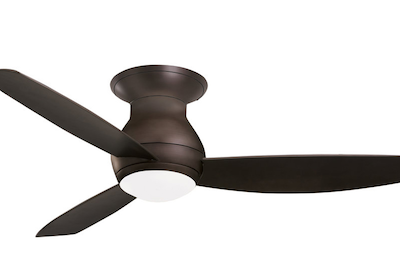The ultimate guide on how to choose the right ceiling fan
#1 CHOOSE THE APPROPRIATE RATING FOR YOUR LOCATION

Is this fan going indoors or outdoors? There are 3 different ratings to consider:
- Indoor Rated: Rated only for indoor use, cannot withstand moisture or direct water exposure.
- Damp Rated: Rated for mild Outdoor use and indoor use; Can withstand heat and cool moisture, such as desert heat or cool mist or fog. CANNOT withstand direct rain or hose exposure.
- Wet Rated: Rated for Outdoor use and can withstand Direct Water Exposure like Rain or cleaning with a hose; You can also use WET Rated fans for DAMP or INDOOR Locations, but not the other way around.
#2 CHOOSE THE RIGHT BLADE SPAN
You want to choose the proportional blade span for the space. Below is a good starting point, keep in mind that if the room is very large, you may want to consider using two fans instead of one.

#3 CHOOSING THE RIGHT DROP
Measure the height from the ceiling to the floor of where you plan on installing your fan. The chart below will give you a good reference guide as to which downrod you should choose. Keep in mind that some homeowners may choose a slightly different drop for preferred "visual" reasons.

#4 CHOOSING THE RIGHT FINISH
There are 3 main finishes/colors for ceiling fan motors. Most fans will come in 3 different options that fall in the category of; silver, brown, and white. There are different variations of these, see below:

- Silver - Silver, Brushed Nickel, Brushed Steel, Pewter, Brushed Pewter, Chrome, Polished Nickel
- Brown - Oil Rubbed Bronze, Brushed Bronze, Maiden Bronze
- White - White, Matte White, Satin White, Appliance White
#5 CHOOSING THE RIGHT CONTROL
There are 3 main types of controls; Pull chain, Remote Control, and Wall Control. In most cases, you can generally add a remote control or wall control to your fan, but hardly ever add a pull chain to one.
ELECTRONIC-BASED CONTROLS

Remote controls and electronic-based wall controls come with a receiver. The receiver goes in the fan in one of three places; in the canopy against the ceiling (most of the time), around the motor, or under the motor in the switch cup. Keep in mind that electronic based controls talk to the receiver in the fan. As with other electronic or appliances, electronic parts tend to require maintenance every few years - Receivers tend to go out between 5-8 years. You will have to replace them.
PULL CHAIN / HARD-WIRED CONTROLLED FANS

Manual fans that have a pull chain can be controlled by hard-wired wall controls. There are no receivers involved therefore requiring less maintenance. If you purchase a ceiling fan with a light, you have to make sure your space is wired (2 hot wires) correctly for a wall control to control both the fan and light separately. If you plan on just controlling a fan with no light, you will be fine with 1 hot wire. If you only have one hot wire and want to control both functions separately, electronic-based controls will help you work around the problem because they only run on 1 hot wire, allowing you to control both functions separately.
TIP: If you have ceilings taller than 12 ft, consider hard-wiring your fans or choosing fans that have the receivers around the fan motor (DC fans are a good example of this). This way, when you have to replace the receiver, you will not have to find an electrician with "special equipment" to replace receivers high against the ceiling, which usually adds installation or repairing costs.
#6 OTHER TIPS TO HELP YOU FIND THE BEST FAN
- DC Motors are the newest addition to the ceiling fan industry, because they are magnetic based they are the most energy efficient, the quietest, and have 6 speeds
- Ceiling fans blow air downward in a cone shape, therefore if you get a fan that is too small, you may not get airflow in the area you want too - or if you get a fan too big, much like a hurricane's "eye of the storm", you may not get air directly below it
- CFMs stand for Cubic Feet per minute and relates to a measurement of how much airflow you get from a fan
- The smaller the fan the more "forceful" air you feel right below, the bigger the fan the more it begins too feel like an "air conditioning breeze"
- The bigger the motor, the better quality the fan; more power, more air, more quieter
- Flushmount or hugger ceiling fans (ceiling fans with no downrods and are flushed to the ceiling) save headspace and are perfect for limited ceiling heights - however, you begin to sacrifice air because the blades are closer to the ceiling which prevents air from filling up the space above the fan before it gets blown down
- The less number of blades tends to result in more "felt air" than a fan of the exact dimensions with more blades - However, the most important component of airflow is motor size
- The less number of blades #1 contributor isn't increased airflow, it is the way the fan looks - try not too focus on airflow output
- Federal Regulations limit ceiling fans to only output a maximum of 180 Watts of lighting for the downlight - to get increased lighting, look at fans with both downlights and uplights
- If you don't see a light on traditional and transitional styled ceiling fans, more than likely you can add one; if you don't see a light on modern and contemporary styled ceiling fans, it is unlikely you can add one
- All fans have the ability to reverse, reverse allows a fan to warm up the space by pushing warm air towards the ceiling allowing it to crawl down the walls to the floor - in turn warming up the space
- Rounder, tropical blades on ceiling fans tend to push air sideways instead of downward, causing less air to be felt - most of the time we recommend that you stay away from these type of fan blades if air movement is a priority
- The closer the fan blades to the ceiling the less air you will feel (this doesn't comply for blades past 12" from the ceiling)
- We recommend you choose hard-wired controlled or DC ceiling fans for ceilings above 12', because changing a receiver thats against the ceiling may require special equipment that could in turn lead to higher electrician costs towards installing or repairing ceiling fans and receivers


















































